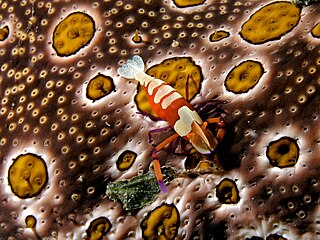
Alvinocarididae is a family of shrimp, originally described by M. L. Christoffersen in 1986 from samples collected by DSV Alvin, from which they derive their name. Shrimp of the family Alvinocarididae generally inhabit deep sea hydrothermal vent regions, and hydrocarbon cold seep environments. Carotenoid pigment has been found in their bodies. The family Alvinocarididae comprises 7 extant genera.

Lysmata debelius is a species of cleaner shrimp indigenous to the Indo-Pacific. It is popular in the aquarium trade, where it is known as the fire shrimp, blood shrimp or scarlet cleaner shrimp.

A giant isopod is any of the almost 20 species of large isopods in the genus Bathynomus. They are abundant in the cold, deep waters of the Atlantic, Pacific, and Indian Oceans. Bathynomus giganteus, the species upon which the generitype is based, is often considered the largest isopod in the world, though other comparably poorly known species of Bathynomus may reach a similar size. The giant isopods are noted for their resemblance to the much smaller common woodlouse, to which they are related.

Makiyamaia coreanica is a species of sea snail, a marine gastropod mollusk in the family Clavatulidae.

Gemmula congener, common name Melvill's turrid, is a species of sea snail, a marine gastropod mollusk in the family Turridae, the turrids.

Gemmula cosmoi is a species of sea snail, a marine gastropod mollusk in the family Turridae, the turrids.

Gemmula damperierana is a species of sea snail, a marine gastropod mollusk in the family Turridae, the turrids.

Gemmula diomedea, common name the albatross turrid, is a species of sea snail, a marine gastropod mollusk in the family Turridae, the turrids.

Gemmula gemmulina is a species of sea snail, a marine gastropod mollusk in the family Turridae, the turrids.

Gemmula speciosa, common name the splendid turrid, is a species of sea snail, a marine gastropod mollusk in the family Turridae, the turrids.

Cryptogemma aethiopica is a species of sea snail, a marine gastropod mollusk in the family Turridae, the turrids.

Periclimenes imperator, known as the emperor shrimp, is a species of shrimp with a wide distribution across the Indo-Pacific. It lives commensally on a number of hosts, including the sea slug Hexabranchus. A. J. Bruce first described it in 1967 based on eight specimens ranging from 4 millimetres (0.16 in) to 7.6 millimetres (0.30 in), and found Periclimenes rex to be its best resemblance.

Gemmula, common name the gem turrids, is a genus of sea snails, marine gastropod mollusks in the family Turridae, the turrids.

Lophiotoma is a genus of sea snails, marine gastropod mollusks in the family Turridae, the turrids.
Periclimenes dardanicola is a species of shrimp found in the western Pacific Ocean. It lives in association with sea anemones that live on the gastropod shells carried by hermit crabs. It was first named by Alexander J. Bruce and Junji Okuno in 2006. It is mainly white, and grows up to a carapace length of 4 mm (0.16 in).

Palaemonella is a genus of shrimp in the family Palaemonidae, containing the following species:
The Pseudosquillidae are a family of mantis shrimp containing four genera and 11 species.
Periclimenaeus is a genus of decapod crustaceans of the family Palaemonidae which is part of the infraorder Caridea. The genus was named by the English carcinologist Lancelot Alexander Borradaile in 1915. He set out the distinguishing features of the genus as:
Body rather stout, cephalothorax deep, a good deal compressed, abdomen greatly curved Thorax without dorsal swelling. Rostrum rather short, compressed, toothed above only. Outer antennular flagellum not deeply cleft. Antennal scale of good breadth. Mandible without palp. Second maxilliped without podopalp. Third maxilliped narrow, with vestigial arthrobranch.

Periclimenes, commonly known as glass shrimp or cleaner shrimp, is a commensal and often symbiotic genus of semi-transparent shrimp within the family Palaemonidae. Species of this large genus feature a wide variety of coloration and patterns, widespread distribution throughout much of the world's tropical oceans, and are often sought out for aquarium trade.
















